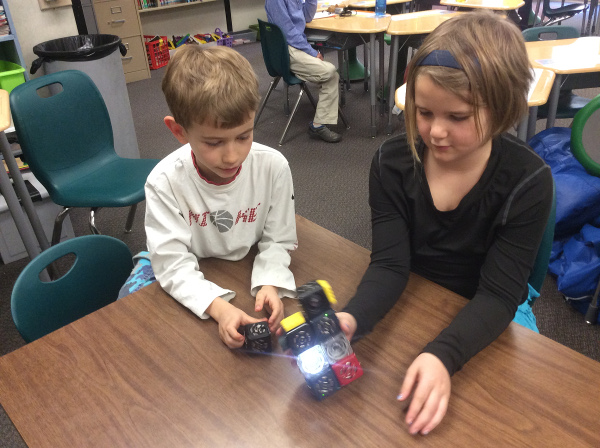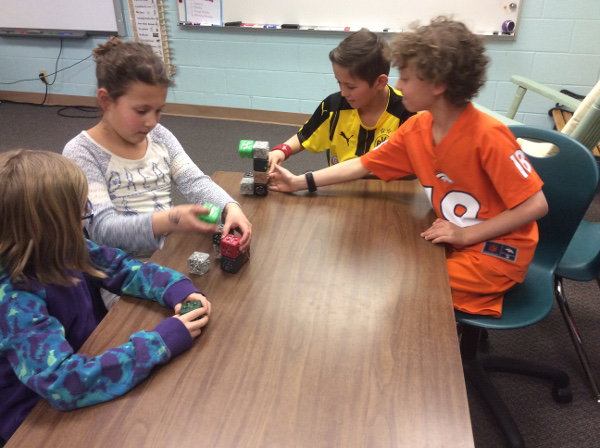As District Staff Developer for Elementary Science at Pinellas County Schools, James Hite has a big job. 78 schools alone rely on his expertise, especially when adding a new tool like Cubelets to their programs.
Mr. Hite trialed the little robots in ten classrooms and quickly discovered how engaging and versatile they are. Today, Cubelets are found in every Elementary Science lab in the district with over 14,000 students playing and learning with robot blocks.
“Cubelets play a huge role in our science programs,” Mr. Hite explains. “All 2nd- and 4th-grade students are using Cubelets to solve complex problems and conduct various investigations.”
Of course, these investigations with Cubelets aren’t always so structured.
“In one of our science labs, students built a robot that would be used to transport their class gecko around. Sure enough, the robot was constructed, and the gecko rode around the classroom in style in his custom robotic transport.”
Continue reading
Tag Archives: grade: 1-5
Ask Brandy Ray for her favorite Cubelets moment, and she’ll tell you about watching three- and four-year-olds using Cubelets to explore robotics.
It was so fun to watch their understanding unfold! We did so many Cubelets challenges in the classroom. We even used Cubelets as a way to teach math and science concepts such as sorting and human senses. Before long, my students were able to understand that each Cube is programmed to be a sense, think, or act Cube, and that each of these Cubes influenced the behavior of whatever they’d created. After creating a Fraidy Bot, one of my three-year-old students shared, “It senses your hand. I can drive it to you!”Now a fifth-grade teacher at Mackintosh Academy in Boulder, Colorado, Ms. Ray has used Cubelets in a variety of classroom settings across a wide age range. She utilizes Cubelets to teach concepts such as computational thinking, cause and effect, and the different components of a robot. Cubelets robot blocks allow for “hands-on inquiries,” a method she finds valuable for instilling these lessons. Ms. Ray has seen first-hand the kind of impact Cubelets have had on her students. Cubelets have taught her students techniques for how to problem-solve, an important lifelong skill. She has watched older students experiment to find out how a particular THINK block works, and has challenged younger students to try to build a robot using only three Cubelets blocks. She finds that Cubelets are a useful way for her to teach math concepts like sorting, as well as for modeling science concepts. Ms. Ray observed her students learning the principles of cause and effect using Cubelets. They also explored how each robot block is programmed to perform a specific function, and that each one will influence the whole robot construction in different ways. For her fellow educators, Ms. Ray acknowledges that working with materials and concepts that they may not be familiar with can be intimidating. Nonetheless, she encourages teachers to take the risk and try out Cubelets in their classrooms. She has found that, even right out of the box, Cubelets can be used to investigate a variety of content areas. But more than that, Ms. Ray says, “It’s so fun to watch a student figure out how Cubelets work. Surprise and excitement light up their face!”
Robot fun has made it into summer camps! With 40 locations in the US, Steve & Kate’s Camp leaders were excited to add Cubelets to their activities in 2017. With the addition of Cubelets, they found that robotics has been a popular offering in their camps.
Michaela Clinton, Camp Director in Denver, worked at camps for 15 years before joining Steve & Kate’s. She was “drawn to the educational philosophy of letting kids express themselves in ways they may have never been able to before.”
Continue reading
Michael Jaber has seen first-hand the profound effect Cubelets robot blocks have on students. Students who tended to sit back now step up and lead; those who were shy are now willing participants. Those who previously had no interest in STEM have joined the STEAM Team at Jefferson Elementary School in Sheboygan, WI.
Mr. Jaber is the Coordinator of Instructional Technology. Every Thursday afternoon, he spends time in classrooms showing students new technology gadgets. As one of the featured gadgets, Cubelets have piqued the interest of all the students. Cubelets are used to explore robotics using a constructivist approach, and Mr. Jaber has seen teacher Diane Moon successfully use them in the Next Generation Science Standards fifth-grade curriculum.
When Jefferson Elementary first received Cubelets, they used them in a technology center rotation to allow students to explore and determine what the function of each robot block was This lead to purposeful conversations and the students worked together to create the specific robot construction that they had in mind.
Continue reading
Jamie Roth uses Cubelets not as an add-on to her curriculum, but as an enhancement to her current lessons.
“Teachers are frequently asked to add more into our already packed curriculum,” she says, “and time is always a factor. So, it’s extremely helpful when you find an authentic, engaging, hands-on tool to enhance curriculum and to spark that excitement in our students.”
Ms. Roth teaches second grade at Fireside Elementary in Louisville, Colorado. She has been using Cubelets with her students for two years. When she introduces Cubelets to her students, she utilizes the free lesson plans for grades 1-3 and has had great success with them. She has found the best way to start is to begin with the “Robots and Sensing” lesson. After that, she guides her students through the other three lessons, which give them a deeper understanding of Cubelets and robotic behavior.
“Because of Cubelets, my students communicate and collaborate well with their teammates,” she says. “They are excellent listeners and love sharing their ideas!”
Continue reading
Barbara Grindle knows the endless possibilities that Cubelets robot blocks offer to students of all ages. A third-grade teacher at Marshdale Elementary in Evergreen, Colorado, Ms. Grindle serves as her school’s Gifted and Talented Building Liaison, as well as the STEAM Class Coordinator.
She likes to use Cubelets in her Friday Afternoon Clubs as an exploration exercise. She challenges her students to experiment and determine what each robot block does, as well as figure out how they work together. In her after-school STEAM class, Mrs. Grindle uses Cubelets and the Cubelets Blockly app to explore coding.
For Ms. Grindle’s students, Cubelets have fostered a variety of engaging lessons that develop 21st-century skills. She advises her fellow educators to think about what they can teach using technology, as opposed to what they can teach about technology.
 She has witnessed Cubelets helping students, including those with special needs, open up in ways she never thought possible:
She has witnessed Cubelets helping students, including those with special needs, open up in ways she never thought possible:
 Cubelets have helped build bridges between her students in other ways, as well.
Cubelets have helped build bridges between her students in other ways, as well.
 Ms. Grindle admits that she has not even begun to scratch the surface of what is possible with Cubelets.
Ms. Grindle admits that she has not even begun to scratch the surface of what is possible with Cubelets.
 She has witnessed Cubelets helping students, including those with special needs, open up in ways she never thought possible:
She has witnessed Cubelets helping students, including those with special needs, open up in ways she never thought possible:
When I met my new third graders last August, I had a student with severe special needs… I would only get a shy smile from her occasionally. She felt overwhelmed in our regular classroom and would not make eye contact or interact with the students when she was in our room. My teammate and her daughters had a wonderful time playing with Cubelets at the Denver Museum of Science and Nature. She told me to check them out. My first thought was not for my after-school STEAM class, but for this student. Here would be a way for her to equally participate with classmates. I wrote a grant through Donor’s Choose for Cubelets. In the meantime, I saw her and two girls belly laughing while coloring! That was a quite a breakthrough! But none of our activities required enough interaction, or were too difficult for her, and we didn’t seem to make much more progress. She still would not talk to us even though she could now say a few simple sentences. Then the Cubelets arrived. A boy and girl explored the Cubelets with her for several days. Then she started talking to them in complete sentences to help her accomplish what she was trying to get the Cubelets to do! The adults cried and the class cheered when we learned what had taken place. I now get big smiles, sometimes hugs, and an occasional word from her. During our Morning Meeting she will now whisper the information she wants to share to the person sitting next to her. In our current economics unit, one of our students chose her for a business partner and they are making products to sell on our third grade Market Day. This is a newfound engagement with the whole world!
 Cubelets have helped build bridges between her students in other ways, as well.
Cubelets have helped build bridges between her students in other ways, as well.
Recently, a new 5th-grade student enrolled in my STEAM class. She does not speak any English and I do not speak any Spanish. Knowing the power of the collaboration possible with the Cubelets, I had her try to figure out how to use them. I had purchased extra battery cubes so more than one child at a time could work with them. After two classes using the Cubelets and getting comfortable with us, she was ready to take on other more complicated activities like building in Minecraft EDU. It was the excitement and success of working with others with the Cubelets that helped her transition and take risks.
 Ms. Grindle admits that she has not even begun to scratch the surface of what is possible with Cubelets.
Ms. Grindle admits that she has not even begun to scratch the surface of what is possible with Cubelets.
The impact of the Cubelets constantly exceeds my expectations. I want a way to level the playing field for students to collaborate. I want to extend the concept of coding on a very concrete level by offering a range of coding devices. This one is unique. I want to expose my students to a variety of technology in order to help them become flexible thinkers, problem solvers, innovators, and collaborators. I want to engage struggling students and have them know that learning can be fun and exciting. The Cubelets have helped with all of these. Last night, I sent the Cubelets home with a staff member and her family. She complained, jokingly, that her husband would not put them down. Then she showed me a movie on her phone of how the Cubelets were being controlled by their wall dimmer switch! And he sent me a challenge to do having separate robots interact! I have not begun to scratch the surface of what is possible yet. So I know the impact will end up being much bigger than I can imagine!

